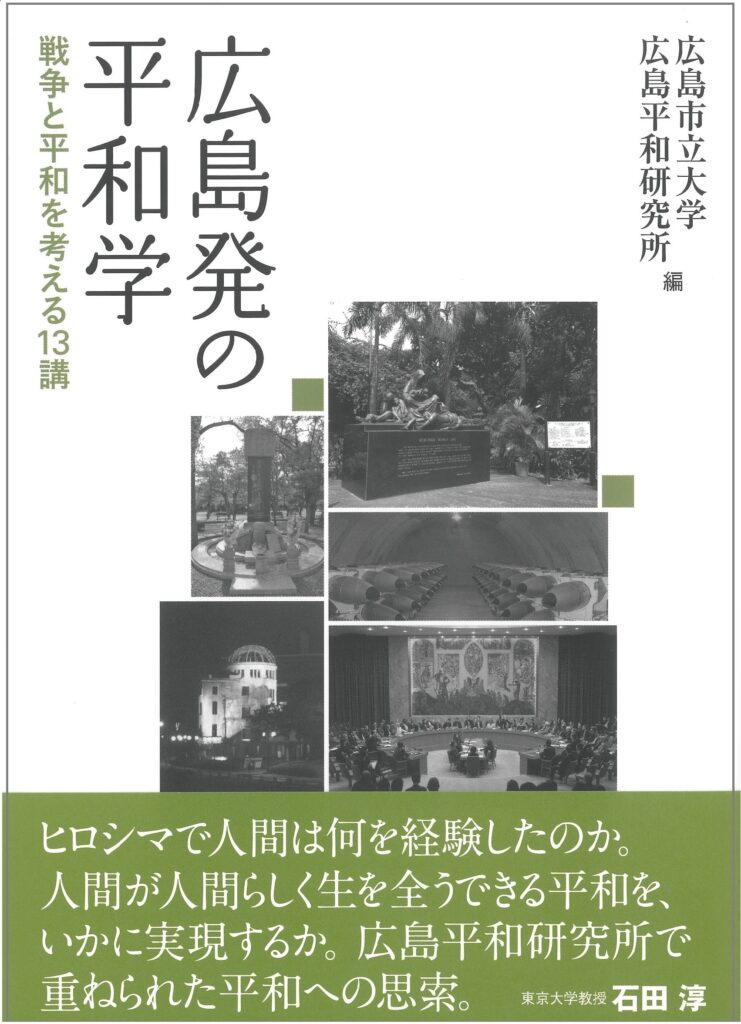
広島市立大学 広島平和研究所/編(法律文化社、2021年8月)
ISBN978-4-589-04165-4
A5判・276頁
本の概要
広島・長崎への原爆投下から75年余りが経過した。被爆者の高齢化も進み、被爆の記憶を継承し、次世代に向けて平和な社会を築き上げていくことが重要な課題となっている。こうした課題への取り組みの一つとして本書は編まれた。
『広島発の平和学』―。本書は、国籍や専門分野の異なる広島平和研究所の教員13名が、被爆地・広島に置かれた研究機関に所属することを意識しながら、原爆体験の今日的な意味や影響、現代の国際社会における平和創造の課題と手立てについて分析を加えたものである。
タイトルの「広島発」にある広島とは何か。広島の自己像は諸外国にどう映っているのか。「力による平和」の論理に頼らず、非暴力的な方法で平和を維持・達成することは可能なのか。核問題は地球環境問題を含むグローバル・イシューズとして、どう捉えられるだろうか。
本書は、このような問いを念頭に置きつつ、原爆体験の教訓を国際的な視座から再考し、人間の生存や尊厳を脅かす要因の分析を通して、平和な世界を構築するための方途を探る。
目次・執筆者
序章 広島発の平和学を目指して(大芝亮)
[第I部 広島とヒロシマを考える視座]
1章 広島における平和と学び(水本和実)
2章 広島への核攻撃と米国の政策、文化、生態系への影響(ロバート・ジェイコブズ)
3章 韓国人が見たヒロシマ(河炅珍)
4章 中国から見たヒロシマ(徐顕芬)
5章 日本による東南アジア占領統治と第二次世界大戦後の発展に与えた影響(ナラヤナン・ガネサン)
6章 ヒロシマとマニラ(永井均)
7章 ヒロシマの語られ方(竹本真希子)
[第II部 平和な世界を創造する手立て]
8章 朝鮮半島の分析と北東アジア安全保障の行方(孫賢鎮)
9章 欧州安全保障協力会議(CSCE)プロセスの再考(吉川元)
10章 気候危機を乗り越える国際制度(沖村理史)
11章 国際法秩序の変容と「武力行使禁止原則」の課題(佐藤哲夫)
12章 憲法九条と核兵器(河上暁弘)
※広島平和研究所教員一覧 https://www.peace.hiroshima-cu.ac.jp/faculty/
※広島市立大学広島平和研究所では書籍の販売を行っておりません。ご注文はチラシをご覧の上、書店あるいはインターネットでご購入ください。
※出版社のサイトはこちらをご覧ください。
A Hiroshima Approach to Peace Studies: 13 Lectures on War and Peace [Hiroshima Hatsu no Heiwagaku]
Edited by the Hiroshima Peace Institute,
Published in August 2021 by Horitsu Bunka Sha
ISBN978-4-589-04615-4
Book Description
More than 75 years have passed since the atomic bombings of Hiroshima and Nagasaki. As the Hibakusha, the survivors of the A-bomb attacks, grow older it becomes essential to convey their memories and interpret their experiences to new generations. This urgency, alongside a fervent desire to work pragmatically towards a peaceful future, are the driving forces behind the publication of the new book, A Hiroshima Approach to Peace Studies [Hiroshima Hatsu no Heiwagaku].
The book consists of chapters contributed by the 13 professors at the Hiroshima Peace Institute of Hiroshima City University. These authors, from many countries and working in a variety of academic disciplines, approach their subjects fully cognizant that their work stems from an academic institute situated in the first A-bombed city, Hiroshima. From this common origin each works to analyze the significance and influence of the experiences of Hiroshima and the challenges we face to sustainable peacebuilding in today’s diverse international society, providing perspectives from multiple national and academic vantage points.
Each author approaches their topic with the following questions in mind. 1) What does the word “Hiroshima” symbolize? How is Hiroshima’s self-image shared, reflected or challenged in other countries? 2) Is it possible to maintain and achieve peace in a non-violent way, counter to the logic of “peace through power”? and 3) How can nuclear issues be perceived as global issues, including global environmental issues?
This book explores the conditions fundamental to building a peaceful world, reframing the lessons of A-bomb experiences of Hiroshima through multiple theoretical and national lenses, and diagnosing the factors that threaten human survival and dignity.
Table of Contents
Introduction: A Hiroshima Approach to Peace Studies (OSHIBA, Ryo)
PART 1: Multiple Perspectives on Hiroshima
Chapter 1 "Peace" and "Studies" in Hiroshima: An Analysis through Atomic Bombing Experience and Peace Education (MIZUMOTO, Kazumi)
Chapter 2 The Impact of the Hiroshima Nuclear Attack on U.S. Policy, Culture and Ecology (JACOBS, Robert)
Chapter 3 Korean Gaze on Hiroshima: Recognition Gap and Variations (HA, Kyungjin)
Chapter 4 China’s Perceptions of Hiroshima: From the Perspective of Foreign Policy (XU, Xianfen)
Chapter 5 The Japanese Occupation of Southeast Asia and Its Impact on Post-WWII Developments (GANESAN, Narayanan)
Chapter 6 Hiroshima and Manila: Experiences and Memories of Loss in World War II (NAGAI, Hitoshi)
Chapter 7 How the World Learnt about Hiroshima: Knowledge Spread to West Germany (TAKEMOTO, Makiko)
PART 2: Means to Create a Peaceful World
Chapter 8 Analysis of the Korean Peninsula Issues and Perspectives on Northeast Asian Security (SON, Hyun Jin)
Chapter 9 Reconsideration of the CSCE (Conference on Security and Cooperation in Europe) Process: The Power of International Norm and Institution for Peace Creation (KIKKAWA, Gen)
Chapter 10 International Regimes to Overcome Climate Crisis: Required Global Perspective and Cooperation (OKIMURA, Tadashi)
Chapter 11 Transformation of the International Legal Order and Challenges for the Prohibition of the Use of Force: Functions and Limits of the Fundamental Principle for Eradicating Wars (SATO, Tetsuo)
Chapter 12 Nuclear Weapon and the Constitution of Japan, Article 9 (KAWAKAMI, Akihiro)
HPI Faculty Members https://www.peace.hiroshima-cu.ac.jp/faculty/
